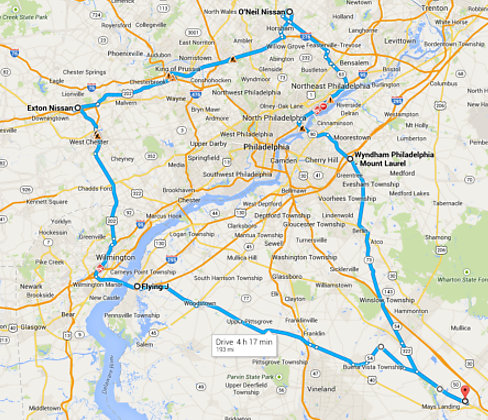Yesterday I did a road trip, 465.5 km round trip (289.25 miles), from Burnaby, BC to Seattle and back.
The trip included 10 DC quick charge sessions and 1 Level 2 charge.
Two of the quick charge sessions were top-ups from 80% to 95%, in order to make sure I had enough range to handle the longest stretch of the trip, between Burlington, WA and Everett, WA (about 69 km). I used 13 bars on this leg each time. I might have made it with only 80%--I would have been down to one or zero bars if I would have attempted this--but I did not want to risk it on such a long day trip with my son in the car.
Total charging cost: $33 USD.
- $20 monthly charge for unlimited Aerovironment charges (I had 5 sessions on the AV DCQC chargers, which are $7/session without the monthly subscription).
- $9 on the Chargepoint unit at Magic Nissan in Everett, WA (3x$3/session)
- $4 for four hours of charging at a Blink Level 2 charger in Seattle.
Observations:
- I didn't mind the frequency of the stops, it was good to get out of the car, and the 20 minutes at each stop flew by with bathroom breaks, food purchases, and my son's trumpet practice next to the freeway in Burlington. But the time added up and it was a very very long day overall, with heavy traffic between Everett and Seattle each way.
- Since I was stopping so frequently to charge and I had to stop in certain places, I was unwilling to stop anywhere else, even though I would have liked to have done some shopping at places without chargers.
- Cell phone was crucial. The AV charger in Burlington was giving me error messages (and the Miev's "high voltage component" light illuminated each time there was an error). After 4 attempts, I called AV. A rep there remotely reset the charger, and it worked smoothly after that. Next time I won't try 4 times before calling, I'll call right away.
- If one DCQC unit is down or has a major problem, the whole trip would have been impossible. For example, if the AV CSR had not been able to resolve the error in Burlington, we would have been stuck at the Level 2 charger there for several hours and would not have been able to make it to Seattle and back in a day. The possibility that a charger might be down makes the road trips stressful.
- I stopped at DCQC units 8 times, but I only had to wait one time for another car to finish a charge (a 5-minute wait). I felt lucky that there were no lineups at the chargers.
- When I was paying attention, I limited my speed to 100km/hour. During leg 7 (see below, I was not paying attention to speed and went along with the flow of traffic at 115 km/hr for about 10-15 minutes. I noticed my RR decreasing much more rapidly at this higher speed.
- On the charges that stopped at 80%, I noticed when I turned on the car it usually showed 14 bars, but as soon as I started driving it went down to 13 bars.
Data (sorry these are incomplete, I don't have data for AV chargers):
Leg 1: home to Surrey Museum, 36 km, charged for free up to 80%, 4.3 kWh in 13 minutes.
Leg 2: Surrey Museum to Sehome Village in Bellingham, WA, 51.1 km, charged up to 80%.
Leg 3: Sehome Village to Burlington Outlet Mall, 38.7 km, charged up to 80%, then a second session up to 95%.
Leg 4: Burlington to Magic Nissan in Everett, 68.7 km, down to 3 bars by the end. Charged up to 80% for $3, 8.4 kWh in 17 minutes.
Leg 5: Magic Nissan to Safeco Field, Seattle, 39.2 km, went from 13 bars to 8 bars, charged up to 100% for 3+ hours at Level 2, $4.
Leg 6: Safeco Field back to Magic Nissan, stop and go crawling traffic, only down to 12 bars by the time I arrived, but still felt like I needed more than 80% to be sure of making it to Burlington on next leg, two DCQC sessions, $6, first one up to 80%, 2 kWh in 6 minutes; second one up to 96%, 1.7 kWh in 12 minutes.
Leg 7: Magic Nissan to Burlington, down to 3 bars by the time I arrived, charged up to 80%.
Leg 8: Burlington to Sehome Village in Bellingham, charged up to 80%.
Leg 9: Sehome to Surrey Museum, charged up to 80%, 7.6 kWh in 16 minutes.
Leg 10: Surrey Museum to home.
I welcome your feedback.


